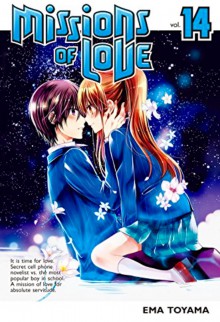
The first omnibus volume introduced Hikage, Hinata, and Teru. Hikage starts off practically invisible to everyone around her except Hinata and Teru. In the first volume, we learned that Hinata has a crush on Hikage. Hinata's jealous fans - one girl in particular - start bullying Hikage for spending too much time with him. In the end she's able to stand up to them.
Whereas the first omnibus volume was focused more on Hikage and her efforts to make friends, this omnibus volume was focused more on Hinata and Teru and the mystery of Black Rabbit's identity. Hikage is convinced that Hinata is Black Rabbit, a possibility that's initially appealing but then fills her with horror and embarrassment. Black Rabbit is her kindest and most supportive online friend. If Hinata is Black Rabbit, that could mean that her "friend" was really laughing about her behind her back as he was encouraging her to talk to him more. Hinata keeps denying that he's Black Rabbit, but he's clearly hiding something.
Things become even more difficult for Hikage when Teru realizes that he has a crush on Hikage too and the two best friends, Hinata and Teru, ask her to choose between them. While Hikage tries to figure out what to do, the wedge between Hinata and Teru starts to tear their entire class in two.
I felt so-so about the first omnibus volume, but since this series is so short I felt like I should finish it anyway. This final omnibus had some parts I liked and some I loathed.
I liked the closer look at Hinata and Teru's friendship. Now that I know Black Rabbit's secret (which I didn't clue into while reading the first volume but figured out a few pages into this one), I have a different perspective on what was going on between Hinata and Teru in the first half of the series. The first half of this volume, when Hinata and Teru were still actively trying to make sure that whatever each of them might be feeling for Hikage didn't hurt their friendship, was fine. Unfortunately, it fell apart when the love triangle reared its ugly head.
I hated the love triangle. Once Teru realized that he was in love with Hikage, his and Hinata's relationship devolved into a competition over Hikage. Teru was a liar, too - he'd say that he didn't want to make things difficult for Hikage, but then he'd explicitly ask her to choose between him and Hinata. Since Hinata and Teru's friendship turned out to be the glue that held the entire class together, asking Hinata to choose meant she'd also be responsible for the class group breaking in half, a fact that her fellow classmates picked up on right away (and almost piled on her for). Hikage found herself at risk of not only losing her budding romantic relationship and all her friendships and budding friendships, all because of this stupid love triangle.
The love triangle resolved itself less painfully for the characters than I expected, but that was mostly because Toyama allowed the tension between Hinata and Teru to just sort of magically evaporate. Some aspects of the love triangle never quite went away, despite Hikage making her choice, which left me wondering whether the issue had really been resolved. I suppose it could morph into an inside joke shared by all three of the characters...
In addition to the love triangle, I also hated that the bullying storyline came back, with the exact same bully. Even though her previous plans resulted in her own public humiliation, Aya decided to jump back into the fray with new plans...that could easily be traced back to her and used to humiliate her a second time. Because this is supposed to be fluffy shojo starring a super-sweet heroine, instead of humiliation Aya got an apology, a smile, and an encouraging speech.
Meanwhile, I'm the horrible person who thinks that there was nothing for Hikage to apologize for. Aya was in the wrong for thinking that Hinata was supposed to be some kind of untouchable idol and trying to keep others away from him. She was also in the wrong for bullying Hikage for getting close to him. She made it worse by impersonating several people in the love triangle to further screw up everyone's relationships, all so she could win over a guy who'd already made it clear he wasn't interested in her.
On the plus side, I was glad that Hikage's online relationships didn't quite work out the way I originally thought they were going to. It wasn't as neat and tidy as "Black Rabbit is this person from Hikage's offline life and Mega Pig is that person," and I liked the recognition that the way people interact with others online might not always match how they interact with them in person. So there's that. (And yes, characters could use their flip phones to post comments on Hikage's blog. They do it on-page in this volume, answering the question I had back while I was reading the first volume.)
I didn't hate this series, but this half of it was definitely weaker than the first half, and the first half was mediocre. Parts of the series were stronger than I expected, but the bullying storyline and the love triangle were both annoying. If ever there was a series that I wish had completely ditched its romance aspect and just focused on friendship, it's this one. I was more than a bit horrified when Hikage examined her feelings for Hinata and Teru and began to lean towards the "romantic relationships are more important than friendships" answer. The series didn't quite work out that way, but I still wasn't a fan of how Toyama handled things.
Extras:
The volume includes several author sidebars featuring a not-particularly-interesting comic series starring Mega Pig (the actual cartoon animal) and Mahi (the sunflower character), character profiles for Hikage, Hinata, and Teru, a short comic starring fourth-grade Hinata and Teru, a few pages of humorous short comics, and a few pages of translator's notes. There's also a bonus comic starring Mega Pig (his offline self), which was kind of cute and tied up a few loose ends from the main series.
(Original review posted on A Library Girl's Familiar Diversions.)

 Log in with Facebook
Log in with Facebook 


















